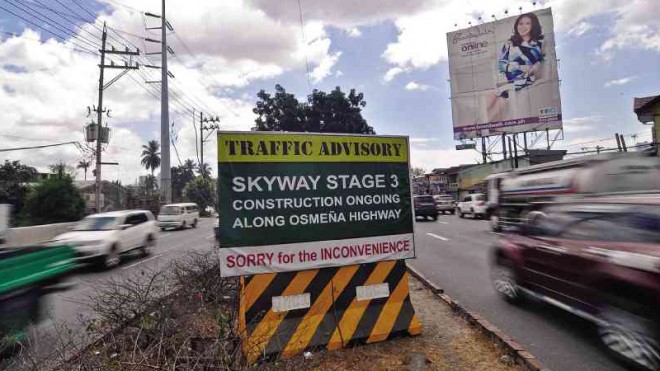
A traffic advisory for the construction of the Skyway Stage 3 project is displayed along Osmeña Highway in Manila. FILE PHOTO/RICHARD A. REYES
A delay in three ongoing infrastructure projects is expected to cause more traffic in Metro Manila in the coming months, the Metropolitan Manila Development Authority (MMDA) announced on Monday.
In a meeting with DMCI Holdings Inc., MMDA Chair Francis Tolentino said DMCI informed the MMDA that the accomplishment dates for the NAIA Elevated Expressway, Skyway Stage 3, and the LRT 2 Extension Project would be delayed.
“We agreed that they will have to designate spokespersons for the three projects to explain the status and the reason for such delays,” the MMDA chair explained.
He revealed a five-month delay in the completion of the Ninoy Aquino International Airport (NAIA) Elevated Expressway.
The NAIA project, a four-lane elevated expressway which spans for seven kilometers from Sales Road in Pasay City to Macapagal Avenue in Parañaque, is expected to provide better access to the airports and reduce traffic congestion along nearby roads.
Once completed, travel time from the Skyway to Terminal 1 is estimated to be reduced from 24 minutes to eight minutes. The P15.86-billion project was targeted to be completed by October this year just in time for the Asia-Pacific Economic Cooperation (APEC) scheduled on Nov. 18 to 19.
Tolentino said APEC delegates were supposed to use the expressway from the airport to the convention venues at the Entertainment City in Parañaque, but with the delay, Tolentino said they would have to utilize Andrews Avenue.
“They also admitted that there was a clogged drainage near Park ‘N Fly in Pasay, which causes flood in the area, but they have expressed intention to help in clearing the drainage,” the MMDA chair added.
As for the Skyway 3 project, Tolentino said that the December 2017 target completion might have to be moved to April 2018.
The Metro Manila Skyway Stage 3 Project is a 14.82-kilometer elevated expressway from Buendia to Balintawak which is targeted to decongest Edsa; ease traffic along other major roads like Quezon Avenue, Araneta Avenue, and Nagtahan; and have fast access to eight interchanges — Buendia, President Quirino Avenue, Plaza Dilao and Nagtahan, Aurora Boulevard, E. Rodriguez Avenue, Quezon Avenue, Sgt. Rivera, and Balintawak.
The P26.65B project is also expected to lessen the travel time from Buendia to Balintawak from the usual two hours to just 15 to 20 minutes.
“While this project is being completed, we should expect heavy traffic along Osmeña Highway in Makati and Manila, Araneta Avenue in Quezon City and other areas affected by the construction,” Tolentino said.
Meanwhile, for the LRT 2 Extension project, the MMDA chair said DMCI insisted that they start Sept. 17, but he claimed that the agency asked them first to provide temporary traffic signals along Marcos Highway.
“Maybe they can start the project on Sept. 28 once this requirement is met,” he added.
They said the extension project would involve the construction of a 3.9-kilometer “fully elevated viaduct” along Marcos Highway and two additional stations: one in front of the Robinsons Metro East and Sta. Lucia East Grand Malls, and the other at the Masinag Junction in Antipolo City.
Expected to be completed during the third quarter of 2017, the LRT 2 extension project is targeted to serve an additional 75,000 passengers every day. The Department of Transportation and Communications claimed that using the additional stations of the LRT 2 would cut the travel time from Masinag to Recto to only 36 minutes compared to the more than 1 hour of travel time via PUVs.
Since all these infrastructure projects are still ongoing, the public should expect traffic congestion in adjacent and connecting roads, according to Tolentino, but big relief would come with the completion of these major road projects.
Asked if the reasons for the delays were acceptable, Tolentino said a lot of factors contributed to the delays, mainly right of way issues and water lines that were affected by the project.
The MMDA earlier warned the public that the simultaneous construction of major infrastructure projects in Metro Manila would worsen the traffic jams. Tolentino even suggested a four-day work week for metro workers, but it was not approved.